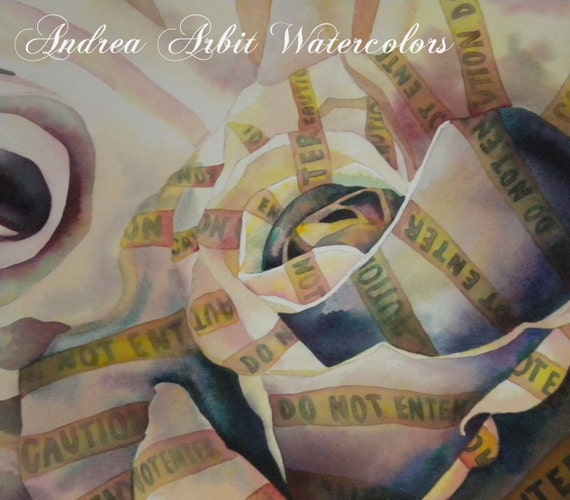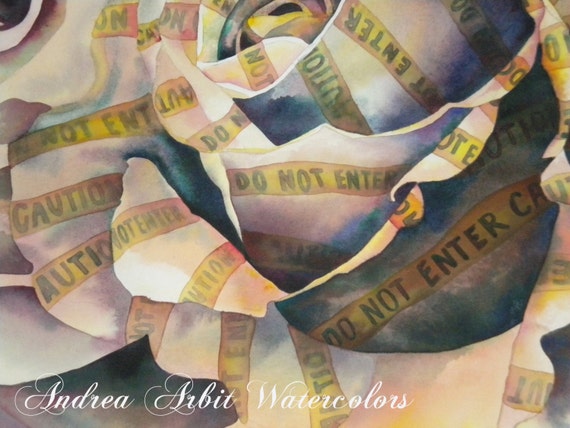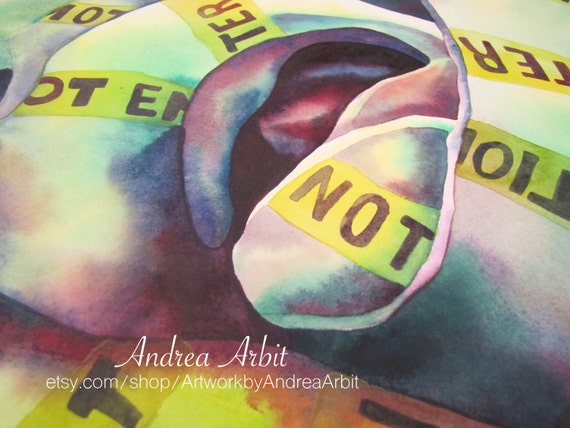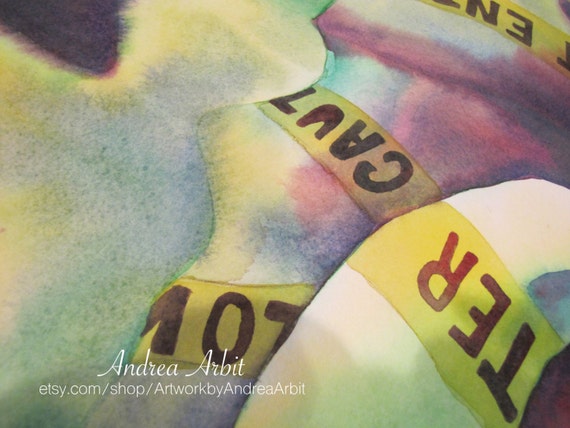Alright, so in yesterday's blog post, I started talking about my thesis from 2010. I hope this topic is interesting to you, because I plan to say a lot more on the topic, and go through all of the paintings I created for it. Today I'll be looking at the second and third paintings I completed for the thesis: Silk Caution and Poisoned Rose.
As you may remember from yesterday, my thesis was born because I both yearned for self-confidence in my body and my sexuality, and felt that such self-confidence was out of my reach.
I was raised in a Baptist church in Michigan. I even attended a private Christian academy for Kindergarten and first grade, and it was in Kindergarten that I "accepted Jesus as my personal savior." In fifth grade, I won a "Teen Study Bible" for memorizing the names of the books of the Bible and reciting them to an adult Sunday School class. I was 10. The Teen Study Bible had several glossy, colorful pages sprinkled throughout that offered Biblical advice on topical issues like friends, family, school, etc. - and the very first of these colorful distractions was bright orange and had the word SEX in big neon green letters at the top of the page. Unsurprisingly, it taught abstinence. There were a few FAQs at the bottom of the page where kids (or adults writing copy, posing as kids) asked how important it really was to save themselves for marriage, and what to do if someone was trying to pressure them into having sex, but there were no FAQs that might actually be helpful to someone who might have had real questions.
This sort of attitude about sex was the attitude I continued to hear about once I graduated into our church's middle school youth group. Sex was always presented as this Thing That Was to Be Avoided At All Costs, a Thing That Might Accidentally Happen To You If You're Not Careful Enough and Stand Too Close to a Boy, a Thing That Is Supposedly Wonderful and Amazing - But Only Allowed For Married, Heterosexual Adults. I was pretty terrified of the whole idea of sex, to be honest. It wasn't a big sacrifice for me to "pledge" myself to God, to promise that I wouldn't have sex before marriage. Sex wasn't something I actually wanted to do. I asked my parents for a silver ring with the words "True Love Waits" engraved on it. I read Christian books. I did not masturbate. I half-heartedly tried to use tampons but couldn't figure out how to get them inside my vagina, so I stopped trying - even when that meant my mom had to send my (male) gym teacher an email to explain that it wasn't fair for him to jeopardize my straight-A average because I couldn't wear tampons. During our swimming unit, I had to sit out for one week out of every four, and then I had to come in to school at 6 AM every Wednesday to make up the hours I'd missed while I was bleeding into my sanitary pads on the bleachers.
I saw sex (in general) and my vagina (specifically) as shameful and mortifying. Still, I happily, willingly, and actively participated in my own sexual repression because I thought it's what I was supposed to do, what good girls did, what good Christians did. I was even kind of perversely proud at the extent of my vagina's "purity" - that it had never even been besmirched by my own fingers or a tampon.
And then I took a Humanities class my senior year of high school, and I learned about other religions and historical attitudes and I started considering the negative side of gender roles for the first time. And then, as I grew enlightened and liberated in my thinking, I also grew ashamed and mortified of my shame and mortification. I decided everything I had grown up believing was wrong. I decided I wanted to figure out how to use tampons and I wanted to have sex and I wanted to explore my body and find confidence in my sexuality and I wanted to experience an orgasm. I also decided that my Christian upbringing was at least partly at fault for the attitudes I had about myself and my sexuality, a realization that led to (but was not the sole reasoning behind) my decision to step away from Christianity. I realized that I no longer believed in God. I tried to have faith in myself, instead. But I had no precedent in these new life changes, and I struggled to find my confidence - in many areas, but especially in my sexuality. I met my husband as a freshman in college. He too was inexperienced. We were each other's first relationship.
With all that back story, I think it becomes a lot clearer why I might have painted the watercolors I did - not only did I look at the first watercolor in what would become my undergraduate honors thesis and interpreted the patterns on rose petals as tattoos on flesh, but I was jealous of that rose's self-expression and felt that my own rose could never get away with such pretty decoration.
The next painting I created was Silk Caution. (Available for purchase through my Etsy shop.)
Instead of patterns, this rose is branded with yellow police tape reading "Caution" and "Do Not Enter." The rose is not actually wrapped in the tape; the actual rose petals themselves display the ribbons like birthmarks. I think of them as literally part of the petals, like the caution tape was manufactured and maintained by the rose. Maybe the rose was encouraged to grow that way, maybe she was cultivated by gardeners to display that particular message, but the message still comes, at least in part, from the rose itself. It was not forcibly held down and wrapped in tape. Like me, it participated in its own repression - because it was taught to do so.
Next to the rose is a spiral of silk, mimicking the shape of the rose. Other watercolorists in my studio class interpreted these dual circles as making the shape of an infinity sign, or as forming a pair of women's breasts. It was also noted that comparing the rose with silk made the rose seem even more soft, more delicate than it might already be, and that it was strange to see something so harmless covered in "caution" warnings. I was asked if the caution tape was in place to protect the viewer from the rose or to protect the rose from the viewer. When I was painting it, I'd thought only of protecting the rose. I identified with the rose. I imagined that it had put the caution tape on its own petals, as a way to avoid the world.
In my thesis, I said that the caution tape might be unjustifiably used, that perhaps the rose and viewer do not need to be protected from each other. But now I question where caution tape even can be "unjustifiably" used. Who decides what's justifiable? Does it matter if there are "real" dangers - to either the rose or the viewer - if either of them perceive the real possibility of dangers? Is it not enough for the rose to want the safety net of wearing that tape - does she need a specific trauma she's responding to, a specific reason? And is it not worthwhile for the viewer to be warned that things might not always be what they seem - even if, in this case, the rose is what it seems to be: a flesh-colored flower, harmless and meek and not inherently dangerous?
For the next painting I created, Poisoned Rose (also available for purchase through my Etsy shop), I changed the color palette so that the rose would actually look unsafe. The green and purple and yellow look like bruises, like sickness, like poison. In my companion written thesis, I again asked the reader to consider who put the caution tape on the rose, and what the intent of the caution tape was. Even though this rose looks more dangerous, that doesn't mean it actually is. I wrote: "The wings of a non-poisonous butterfly might mimic the bright colors of poisonous butterflies as a survival tactic. Might the rose be green to ward off potential predators?"
Of course, this doesn't apply only to sex, to sexuality, or even only to women. Many of us put up walls to hide behind. We might project a "don't come near me" vibe in new, uncertain situations, until we get a feel for the other people around us and whether or not they can be trusted. As an extreme introvert with avoidance and low self-confidence issues, I do this a lot. I stay in a corner. I don't reach out. When I am spoken to, I keep my answers short, on the verge of impolite. I'm not trying to be mean, or rude. I do it because I'm anxious, or apprehensive, or afraid. I do it because I'm not used to acting extroverted, because I feel comfortable and safe doing what I've always done. I do it to protect myself, even when I don't actually want to protect myself so much from life that I miss out on experiencing the joys of life around me. I might even sometimes do it because of a misguided attempt to protect others from having to get to know me, if I'm riding a particularly cruel wave of self-imposed, self-sabotaging low self-esteem. I don't always know why I do it. Maybe this rose doesn't know either.
I named my thesis painting series "Hesitant, Hurt, and Healing Flowers." These two paintings fit in to the "Hesitant" category. We don't know what - if anything - is actually "wrong" with them, but we are told to stay away. In that sense, these two paintings are me. In other, later paintings, I show evidence of physical damage; the roses in other paintings have been victims of abuse or rape or female genital mutilation. They are not hesitant - often they are so freshly wounded that they don't really have the opportunity to be hesitant just yet - but if, in the future they chose to be hesitant, I don't think any viewer would blame them.
But what about those of us, like myself, who have no real, obvious trauma that they are working to come to terms with? What about those of us who are uncomfortable with themselves, with their bodies, with their sexuality, with any displays of confidence - not because they've been obviously abused, but simply because of how they were brought up, or because of something ingrained in their genetics or their brain chemistry that is keeping them from being their happiest, most confident self? I have to remind myself often that I do not need a concrete reason to feel something. My feelings have value. I don't need to have been raped to be cautious and hesitant with my body; I don't need to be struggling with PTSD in response to a specific trauma. That is not to say that my "issues" are comparable to someone else's "issues," someone who <i>does</i> have a history of assault or sexual trauma to deal with. But that also doesn't mean my "issues" don't matter in their own right.
It's like systems of privilege. As a white woman I am not going to experience the same discrimination that a woman of color will in her lifetime. I am not trying to compare mine to hers. In fact, I am actively trying not to compare mine to hers. Because when I compare mine to hers, I know she "wins." She will have it worse off than me. And so then I think - how can I complain about A, B, and C, when there are other people who have to deal with X, Y, and Z, which are so much worse. So then I feel bad about feeling bad, because I feel like I don't have a right to feel bad. But using my privilege to beat myself over the head like that doesn't help anyone.
Six years later, I'm still a "hesitant" flower. But I'm trying to work on being less hesitant - another reason for going so "full disclosure" and talking about all this in a blog. I want to better myself by sharing myself, by removing the caution tape I've put up over the years, by dismantling it layer by layer.
Don't forget to check out my Etsy shop for these paintings and others in this thesis series!
As you may remember from yesterday, my thesis was born because I both yearned for self-confidence in my body and my sexuality, and felt that such self-confidence was out of my reach.
I was raised in a Baptist church in Michigan. I even attended a private Christian academy for Kindergarten and first grade, and it was in Kindergarten that I "accepted Jesus as my personal savior." In fifth grade, I won a "Teen Study Bible" for memorizing the names of the books of the Bible and reciting them to an adult Sunday School class. I was 10. The Teen Study Bible had several glossy, colorful pages sprinkled throughout that offered Biblical advice on topical issues like friends, family, school, etc. - and the very first of these colorful distractions was bright orange and had the word SEX in big neon green letters at the top of the page. Unsurprisingly, it taught abstinence. There were a few FAQs at the bottom of the page where kids (or adults writing copy, posing as kids) asked how important it really was to save themselves for marriage, and what to do if someone was trying to pressure them into having sex, but there were no FAQs that might actually be helpful to someone who might have had real questions.
This sort of attitude about sex was the attitude I continued to hear about once I graduated into our church's middle school youth group. Sex was always presented as this Thing That Was to Be Avoided At All Costs, a Thing That Might Accidentally Happen To You If You're Not Careful Enough and Stand Too Close to a Boy, a Thing That Is Supposedly Wonderful and Amazing - But Only Allowed For Married, Heterosexual Adults. I was pretty terrified of the whole idea of sex, to be honest. It wasn't a big sacrifice for me to "pledge" myself to God, to promise that I wouldn't have sex before marriage. Sex wasn't something I actually wanted to do. I asked my parents for a silver ring with the words "True Love Waits" engraved on it. I read Christian books. I did not masturbate. I half-heartedly tried to use tampons but couldn't figure out how to get them inside my vagina, so I stopped trying - even when that meant my mom had to send my (male) gym teacher an email to explain that it wasn't fair for him to jeopardize my straight-A average because I couldn't wear tampons. During our swimming unit, I had to sit out for one week out of every four, and then I had to come in to school at 6 AM every Wednesday to make up the hours I'd missed while I was bleeding into my sanitary pads on the bleachers.
I saw sex (in general) and my vagina (specifically) as shameful and mortifying. Still, I happily, willingly, and actively participated in my own sexual repression because I thought it's what I was supposed to do, what good girls did, what good Christians did. I was even kind of perversely proud at the extent of my vagina's "purity" - that it had never even been besmirched by my own fingers or a tampon.
And then I took a Humanities class my senior year of high school, and I learned about other religions and historical attitudes and I started considering the negative side of gender roles for the first time. And then, as I grew enlightened and liberated in my thinking, I also grew ashamed and mortified of my shame and mortification. I decided everything I had grown up believing was wrong. I decided I wanted to figure out how to use tampons and I wanted to have sex and I wanted to explore my body and find confidence in my sexuality and I wanted to experience an orgasm. I also decided that my Christian upbringing was at least partly at fault for the attitudes I had about myself and my sexuality, a realization that led to (but was not the sole reasoning behind) my decision to step away from Christianity. I realized that I no longer believed in God. I tried to have faith in myself, instead. But I had no precedent in these new life changes, and I struggled to find my confidence - in many areas, but especially in my sexuality. I met my husband as a freshman in college. He too was inexperienced. We were each other's first relationship.
With all that back story, I think it becomes a lot clearer why I might have painted the watercolors I did - not only did I look at the first watercolor in what would become my undergraduate honors thesis and interpreted the patterns on rose petals as tattoos on flesh, but I was jealous of that rose's self-expression and felt that my own rose could never get away with such pretty decoration.
The next painting I created was Silk Caution. (Available for purchase through my Etsy shop.)
 |
| "Silk Caution" by Andrea Arbit - Watercolor painting on paper, 22"x30" |
Instead of patterns, this rose is branded with yellow police tape reading "Caution" and "Do Not Enter." The rose is not actually wrapped in the tape; the actual rose petals themselves display the ribbons like birthmarks. I think of them as literally part of the petals, like the caution tape was manufactured and maintained by the rose. Maybe the rose was encouraged to grow that way, maybe she was cultivated by gardeners to display that particular message, but the message still comes, at least in part, from the rose itself. It was not forcibly held down and wrapped in tape. Like me, it participated in its own repression - because it was taught to do so.
Next to the rose is a spiral of silk, mimicking the shape of the rose. Other watercolorists in my studio class interpreted these dual circles as making the shape of an infinity sign, or as forming a pair of women's breasts. It was also noted that comparing the rose with silk made the rose seem even more soft, more delicate than it might already be, and that it was strange to see something so harmless covered in "caution" warnings. I was asked if the caution tape was in place to protect the viewer from the rose or to protect the rose from the viewer. When I was painting it, I'd thought only of protecting the rose. I identified with the rose. I imagined that it had put the caution tape on its own petals, as a way to avoid the world.
In my thesis, I said that the caution tape might be unjustifiably used, that perhaps the rose and viewer do not need to be protected from each other. But now I question where caution tape even can be "unjustifiably" used. Who decides what's justifiable? Does it matter if there are "real" dangers - to either the rose or the viewer - if either of them perceive the real possibility of dangers? Is it not enough for the rose to want the safety net of wearing that tape - does she need a specific trauma she's responding to, a specific reason? And is it not worthwhile for the viewer to be warned that things might not always be what they seem - even if, in this case, the rose is what it seems to be: a flesh-colored flower, harmless and meek and not inherently dangerous?
 |
| "Poisoned Rose" by Andrea Arbit - Watercolor painting on paper, 20"x22" |
For the next painting I created, Poisoned Rose (also available for purchase through my Etsy shop), I changed the color palette so that the rose would actually look unsafe. The green and purple and yellow look like bruises, like sickness, like poison. In my companion written thesis, I again asked the reader to consider who put the caution tape on the rose, and what the intent of the caution tape was. Even though this rose looks more dangerous, that doesn't mean it actually is. I wrote: "The wings of a non-poisonous butterfly might mimic the bright colors of poisonous butterflies as a survival tactic. Might the rose be green to ward off potential predators?"
Of course, this doesn't apply only to sex, to sexuality, or even only to women. Many of us put up walls to hide behind. We might project a "don't come near me" vibe in new, uncertain situations, until we get a feel for the other people around us and whether or not they can be trusted. As an extreme introvert with avoidance and low self-confidence issues, I do this a lot. I stay in a corner. I don't reach out. When I am spoken to, I keep my answers short, on the verge of impolite. I'm not trying to be mean, or rude. I do it because I'm anxious, or apprehensive, or afraid. I do it because I'm not used to acting extroverted, because I feel comfortable and safe doing what I've always done. I do it to protect myself, even when I don't actually want to protect myself so much from life that I miss out on experiencing the joys of life around me. I might even sometimes do it because of a misguided attempt to protect others from having to get to know me, if I'm riding a particularly cruel wave of self-imposed, self-sabotaging low self-esteem. I don't always know why I do it. Maybe this rose doesn't know either.
I named my thesis painting series "Hesitant, Hurt, and Healing Flowers." These two paintings fit in to the "Hesitant" category. We don't know what - if anything - is actually "wrong" with them, but we are told to stay away. In that sense, these two paintings are me. In other, later paintings, I show evidence of physical damage; the roses in other paintings have been victims of abuse or rape or female genital mutilation. They are not hesitant - often they are so freshly wounded that they don't really have the opportunity to be hesitant just yet - but if, in the future they chose to be hesitant, I don't think any viewer would blame them.
But what about those of us, like myself, who have no real, obvious trauma that they are working to come to terms with? What about those of us who are uncomfortable with themselves, with their bodies, with their sexuality, with any displays of confidence - not because they've been obviously abused, but simply because of how they were brought up, or because of something ingrained in their genetics or their brain chemistry that is keeping them from being their happiest, most confident self? I have to remind myself often that I do not need a concrete reason to feel something. My feelings have value. I don't need to have been raped to be cautious and hesitant with my body; I don't need to be struggling with PTSD in response to a specific trauma. That is not to say that my "issues" are comparable to someone else's "issues," someone who <i>does</i> have a history of assault or sexual trauma to deal with. But that also doesn't mean my "issues" don't matter in their own right.
It's like systems of privilege. As a white woman I am not going to experience the same discrimination that a woman of color will in her lifetime. I am not trying to compare mine to hers. In fact, I am actively trying not to compare mine to hers. Because when I compare mine to hers, I know she "wins." She will have it worse off than me. And so then I think - how can I complain about A, B, and C, when there are other people who have to deal with X, Y, and Z, which are so much worse. So then I feel bad about feeling bad, because I feel like I don't have a right to feel bad. But using my privilege to beat myself over the head like that doesn't help anyone.
Six years later, I'm still a "hesitant" flower. But I'm trying to work on being less hesitant - another reason for going so "full disclosure" and talking about all this in a blog. I want to better myself by sharing myself, by removing the caution tape I've put up over the years, by dismantling it layer by layer.
Don't forget to check out my Etsy shop for these paintings and others in this thesis series!







No comments:
Post a Comment